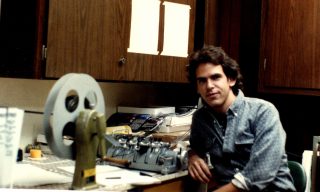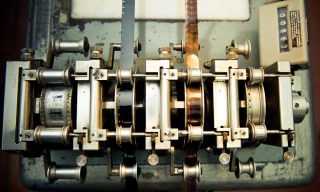
Editor’s Note: “28 Weeks of Post Audio” originally ran over the course of 28 weeks starting in November of 2016. Given the renewed focus on the importance of audio for productions of all types, PVC has decided to republish it as a daily series this month along with a new entry from Woody at the end. You can check out the entire series here, and also use the #MixingMondays hashtag to send us feedback about some brand new audio content.

Back in the days of film, when edits consisted of a piece of tape or some glue, and when fades and effects were created in a lab, firm choices needed to be made at each and every step of the process. With so many different things happening – images shot, developed, edited and exhibited on film, matched with magnetic recording tape playing along in sync, with each involving a myriad of companies, technicians and steep costs, it was important to make solid choices and move on. Today, computers and digital video and audio have allowed for many of the same skills all to be done in a single workstation, and in some cases within a single application.
It may be tough to imagine the way that films were posted in the not so distant past. Film was shot, circled takes were printed and editors dealt with miles of sprocketed film that were then pieced together. Edits and reedits were not a simple task. The sound for film was a completely separate process from the image. Sound was printed onto magnetic sprocket film and the option of a hundred tracks of audio was simply not feasible. Giant mag recorders were in the back of mix stages, playing various sounds in sync with projected film while being rerecorded onto another piece of mag creating the final soundtrack.

I could go on and on about the century long process of film post production, from grease pencils marking film, to work prints and internegatives, to sound editing and mixing, to color timing and final film exhibit prints. Prints that got scratched and broke, were fixed on the fly, remotely, in theatres all across the world, missing frames and more. With so many skills and so many processes, the cost and time involved in filmmaking was considerable, and typically beyond the reach of a hobbyist.
Today you can shoot HD quality video with your phone, dump it into your laptop, open it in a single program like Premiere Pro for the edit, the color and even the sound mixing. Of course, highly specialized applications exist for each of these processes, however, nowadays, as discussed here, they could all be done in one room and mostly on one computer workstation. If someone has the talent and skills, they could perform many of these functions all by themselves. How far filmmaking technology has come!
Often, when wearing so many hats, getting a bit of distance from the project can be tough. Sometimes a producer or director may have trouble making up their mind on a choice or sticking with prior choices. Sometimes it can be tough to realize that the job is done. It can be very myopic when you get stuck on a frame or two of a footstep placement or massaging an edit for better blending or smoothness.
I have a simple rule when editing and mixing and I get stuck – work on the problem for 10 or 15 minutes tops, stick a pin in it, and move on. You can lose whole stretches of time when fussing with minor details. It’s always better to move along, get more done and then there will be only a few things that you will need to get back to. Psychologically, I find it’s better to get the vast amount done before getting tied down with details. Often I find that once the big picture is done correctly, those little things can be cleared up quite quickly.
If you are sound editing and designing your way through a 90 minute feature film, there is a whole lot of ground to cover. A typical feature has thousands of sounds, dialog tracks, music cues and edits. Getting stuck in a tiny detail can derail a whole day, and in post, there is never any time for that. Many times when the post process begins, the film’s schedule is already running late and the timeframe needs more compression.
There comes a time to move on, and there comes a time to call it a day. If a strict schedule is not adhered to, then the time simply will run out and the project will at that point “be done”, no matter what. Filmmaking, with its million tiny elements and choices, by it’s very nature can be tinkered with forever. Fortunately, in the “real world” there are deadlines, premieres and TV start dates, all of which should push you to move ahead. It’s more difficult when it’s a self-funded project or a long term one like a documentary. Sometimes you just have to step away and let it sit for a short time to get fresh eyes and new reference to the work yourself.
Screening to non-partial friends and family who have never seen the project can help. This allows for the chance to experience the project through their eyes. This opens the chance to start to see and feel the pacing, the story strengths and blind spots and what is working and what doesn’t.
As the process advances, there will come a time that it feels mostly there. Screen it again with some new folks and get a feeling for the doneness of it. Eventually you need to admit that one more sound effect, another small trim or a bit more VO will cloud the work rather than enhance it. I’ve seen filmmakers take a perfectly completed project and after a night of “revelation” alter, reedit, remove or add sounds, lines of dialog and music and completely tinker the life out of an already complete project. And yes, soon that revelation vanishes and, if properly saved, can be readjusted back to the prior state.
I like to use a scale of percentage when I evaluate where I am in the process of doneness. If I think that making those changes will change it up by a significant percentage, say 25 or 30 percent, then typically, it’s worth making that effort. If it’s more like 5 or 7 percent, then you at that point you can safely conclude that you are finished.
Only you will know. Unfortunately, due to a million various factors, filmmaking is so complex a process, that some things will never come together exactly as the original intention. Sad but true, some things will never be “right” – but can still be wonderful.
Simply because today’s technology will allow for endless tinkering doesn’t mean that it will make the work any better. Sometimes it’s good to learn the hard fought lessons from the set, to the edit room and the mix on this project, and move on to something new. Learning is always taking place. No filmmaker, or dare I say no artist, has ever said – “that’s it – it’s perfect!”
Sometimes it’s good to just step away, have a deep breath and walk around the block, grab a quick bite or chew the fat with a co-worker, get some distance and look with fresh eyes and hear with fresh ears.
This series, 28 Weeks of Audio, is dedicated to discussing various aspects of post production audio using the hashtag #MixingMondays. You can check out the entire series here.
Woody Woodhall is a supervising sound editor and rerecording mixer and a Founder of Los Angeles Post Production Group. You can follow him on twitter at @Woody_Woodhall


